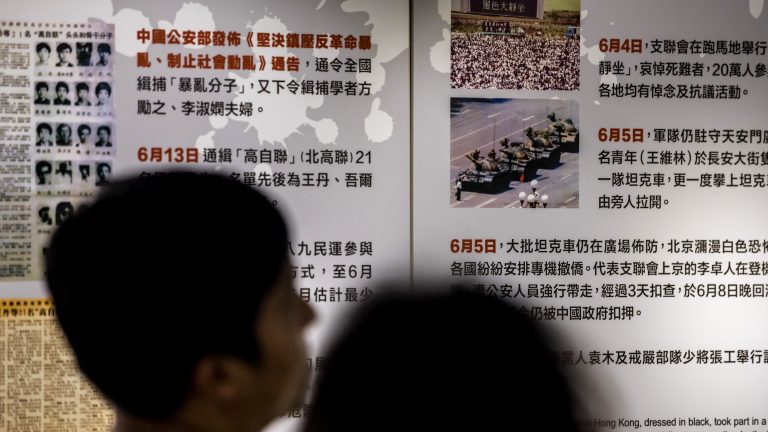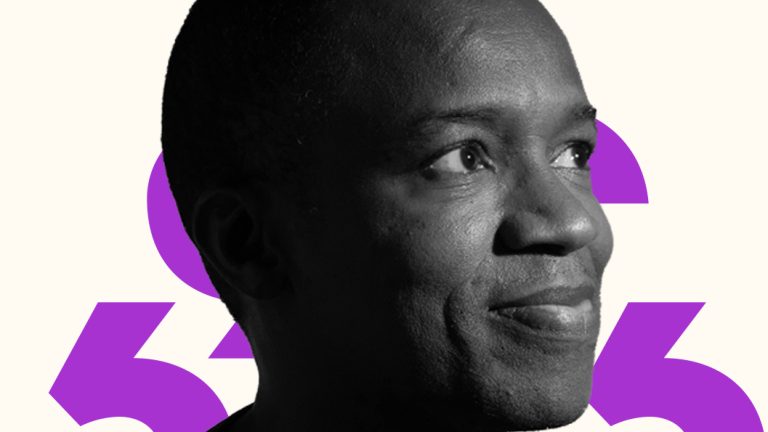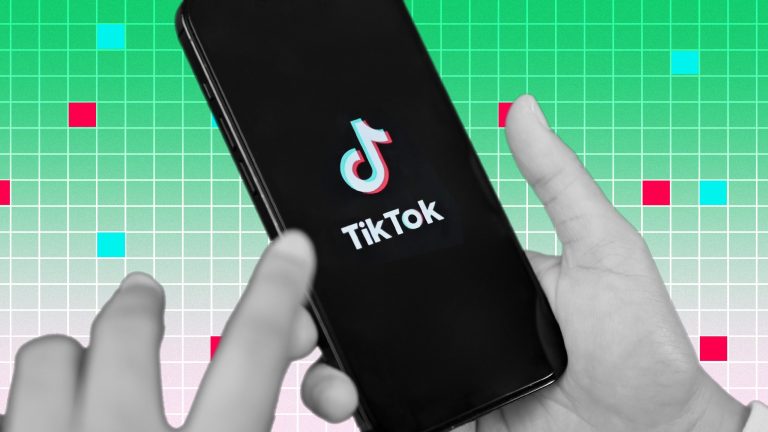The only museum in the world dedicated to preserving the memory of the Tiananmen Square massacre on June 4, 1989, is on the 10th floor of a small commercial building in the Mong Kok area of Kowloon, Hong Kong. In one cabinet, there is a camera, a notebook, and a graduation certificate once owned by Wu Xiangdong, a 21-year-old factory worker who was shot in the neck the night before June 4, 1989. In another, the red helmet worn by Wang Nan, who was a second-year student at Beijing Yuetan High School when he, too, was shot.
The parents of Wu and Wang — alongside other survivors — have donated their possessions for display in this museum. A TV screen broadcasts testimonies from demonstrators and journalists who survived the events, while exhibition boards provide a detailed timeline of the protests. Newspaper clips and official Chinese government documents are kept in a small library.
The museum’s first exhibition was held in 2012 by a group of activists, the Hong Kong Alliance in Support of Patriotic Democratic Movements of China, that formed at the height of the 1989 protests. Every year since the crackdown, it has held a candlelight vigil in memory of those who died.
“The aim of the June 4 museum is to restitute history, preserve the facts, and ensure they don’t disappear from people’s minds,” says Mak Hoi-wah, a 69-year-old social activist who serves as chairman of the museum’s managing committee.
Mak says that, before the pandemic, around a third of the museum’s visitors every year came from mainland China, where the Communist Party has tried to obliterate memories of the events of June 4. An official death toll was never released, but estimates range from several hundred to several thousand. Afterward, student leaders were jailed, and the families of those who died were kept under tight surveillance. Today, publicly discussing the massacre in China is taboo, and mentions of it are scrubbed from literature and social media.
Even in Hong Kong, the museum has been under increasing pressure. The exhibits were displayed at four different locations over the past eight years before finding their current home in 2019. The museum had to move out of its last long-term home, in Tsim Sha Tsui, after the building’s managers sued it for violating land-use regulations — ostensibly because the property was supposed to be an office space, though Mak is sure that the case was politically motivated. The museum has been vandalized on a number of occasions. Just days before it was scheduled to open at its current address, last April, a group of vandals broke into the venue and poured salt water into the electrical sockets and switch boxes.
Since late June, when China’s rubber-stamp Parliament unilaterally imposed a far-reaching national security law criminalizing a broad spectrum of critical speech in Hong Kong, the museum has been on borrowed time. Under the new law, authorities have arrested high-profile activists, raided a major pro-democracy newspaper, and outlawed last year’s most famous protest slogan — “Liberate Hong Kong, the revolution of our times” — for its “separatist intent.”
This year, for the first time in three decades, the June 4 vigil was banned, under the pretense of public safety. Mak, along with more than two dozen other activists, was charged with “participating or inciting an unlawful assembly” after he went ahead with the memorial anyway.
“Since the national security law was introduced, it has become questionable whether we can still continue with the work that we have always been doing,” Mak says. “It won’t be a surprise if they close down our museum — we’re just counting the days to see when this may happen.”
As they wait for that day to come, the museum’s supporters are racing to digitize its exhibits, creating a comprehensive, public, and searchable online database that could become a repository for banned knowledge about the events of 1989 — one beyond the reach of China’s censors. Their efforts are part of a wider movement in the city to chronicle events and preserve history that the Communist Party would rather see expunged.
“People in power tend to rewrite history to enhance their own image. They will never mention their mistakes, and they stop people from mentioning them again,” Mak says. “But without history, we cannot learn from mistakes and make better decisions in the future.”
Since mass protests began in Hong Kong in the summer of 2019, there have been competing narratives about the events in the city.
On July 21, 2019, dozens of white-clad men wielding metal rods attacked commuters at a train station in Yuen Long, in Hong Kong’s New Territories. Dozens of passersby, including pro-democracy lawmaker Lam Cheuk-ting and several journalists, were left bloodied by the attack, but the police took nearly 40 minutes to arrive, later saying that violent protests elsewhere in the city had slowed their response. From there, the story fractured. Some pro-democracy supporters accused police of ignoring intelligence and colluding with the triads. Hong Kong authorities, on the other hand, blamed pro-democracy activists for inciting the violence. Lam was arrested by police for rioting inside the station.
The “7.21 incident,” as it has become known, is one of many that have taken place since last summer where there is no settled account of what happened. Even with near-ubiquitous cameras recording protests, police and demonstrators often emerge with different versions of reality. Police press conferences present highly subjective narratives, while the demonstrators’ mistrust of the police, together with the lack of transparency from the government, has allowed rumors of deaths in custody and other horrors to fester.
In November, Hong Kong saw some of its most violent conflicts at the Polytechnic University, where protesters fired petrol bombs from a catapult as police attempted to raid the campus. It was during these skirmishes that Fu King-wa, a journalism professor at the University of Hong Kong, decided that someone had to start systematically collating information to build a live historical record.
While cameras were capturing the frontline clashes, no one was recording the online conversation, nor the huge organizational effort taking place on Telegram and LIHKG, a Reddit-like forum popular in the city — both essential for understanding the movement.
As one of the founders of Weiboscope, a project that collects censored posts on the Chinese microblogging platform Weibo, Fu had had experience with this kind of work. He hired two research assistants, and together, they started backing up data from nearly a hundred influential Telegram channels where the protests were being discussed and organized. Soon, they branched out, building an archive that recorded where and when tear gas had been deployed by the police and how many people had been arrested, along with a library of more than 71,000 protest posters.
Users are able to browse the posters by typing keywords into a search engine. A glossary gives English speakers with little knowledge of the movement context about the language used in the protests. Locations where tear gas was fired have been visualized on an interactive map, which also allows users to check details about the events that occurred at each location. The database is also published on Hong Kong Free Press — the city’s first crowdfunded English news website.
Fu insists that the aim of the project is purely academic: to provide researchers with data when they come to study the protests in Hong Kong. “We are not activists,” he says. But in Hong Kong in 2020, an archive of this kind is political.
“A lot of the materials that we found — especially on Telegram channels — have already been removed by the police,” he says.
In August, a popular Telegram channel with posters and messages relating to the protests, “SUCK Channel,” was shut down by police after its administrator was arrested on incitement charges.
Fu says that, while the archive is currently hosted by the university network for budgetary reasons, he has saved backup copies and implemented measures to protect their safety. “If, at some point, we finally need to move or migrate to some other place for better security, we can do it easily,” he says.
The new national security law makes it more likely that this could become necessary. The law is vaguely worded, but it is clear that its targets are interpretations of events unfavorable to the Chinese Communist Party.
The new rules have already had a chilling effect. So-called Lennon Walls — public spaces where protesters wrote or pasted political messages — have been removed from Hong Kong shops because their owners worry that the messages might run afoul of the law. The city’s famous protest arts and slogans have mostly vanished from the streets. In August, the city’s Education Bureau made changes to liberal-studies textbooks used in high schools and censored references to the idea of “the separation of powers” between Hong Kong and Beijing. Books written by pro-democracy figures have been removed from public libraries.
There are echoes of Tiananmen everywhere. After the 1989 crackdown, the Communist Party launched a massive propaganda campaign to reset the narrative and change public perception of the massacre. Dissidents were arrested, intimidated, and driven into exile. Later, references to the protests started to disappear from the public domain altogether to prevent people from remembering it.
Louisa Lim, a veteran journalist and the author of the book “The People’s Republic of Amnesia: Tiananmen Revisited,” which examines the fallout from the 1989 pro-democracy movement, says Hong Kong authorities are “copying the playbook” of their counterparts in Beijing after the June 4 crackdown.
“When history is covered up, it is problematic on so many different levels,” Lim says. “There is a problem with the lack of accountability from the very top, and it is also disorientating for the population when people live through an experience but are no longer allowed to speak about it.”

As the protests rolled on into the beginning of 2020, the Hong Kong Alliance held a meeting to explore the future of the museum. They concluded that building the museum online was the best way to secure its long-term future. But, Mak says, the national security law means they are now racing against a ticking clock to ensure history is not lost.
The group is made particularly vulnerable by one of its core demands: an end to one-party rule in China, which could be interpreted as “subversive” under the new law.
“In the future, it is not inconceivable that authorities may use the national security law as an excuse to shut down the June 4 museum,” Mak says. “So we hope that we can finish our digitalization work before that happens.”
The museum launched a crowdfunding campaign in June, and in two months, it raised 1.6 million Hong Kong dollars ($206,400) from more than 1,800 donors. Since then, it has hired a technical team to develop a new website and index the exhibits in an easily searchable database. Simultaneously, a small group of researchers is conducting a new round of data collection to retrieve materials scattered across libraries, government archives, and private collections around the world. They also plan to hire translators to make sure that everything is available in English.
Mak’s team is now working daily inside the museum’s small office to create the online archive. His team has been scanning and indexing documents, as well as conducting research to ensure the new website gives additional context about the 1989 movement’s relevance today. “This effort has been tedious and tremendous for us, but it is valuable,” Mak says. “We want to provide the civil society with an opportunity to search for the truth and understand what really happened.”
The physical exhibits could be removed at any moment — and they have to find ways to protect their digital archives too. They are building a backup website and will have copies of the digitized content stored around the world.
Foreign governments are gradually beginning to release their own classified information about the events of June 4, giving the museum’s archivists more material to help counter-check and verify the eyewitness accounts in their own collections. The museum also hopes to be able to draw attention to the student protests that erupted in other Chinese cities, including Shanghai, Nanjing, and Chengdu, in the summer of 1989, and to give a more rounded picture of the Chinese pro-democracy movement, which has echoes in today’s Hong Kong demonstrations.
“The 1989 social movement was a wake-up call for many Hong Kongers,” Mak says. The events of Tiananmen created a great deal of concern in the city as people began to worry about the impending return to Chinese rule in 1997. Those anxieties drove protestors to the streets again last year.
“Similar to 1989, the anti-extradition-bill protest last year was also heavily participated in by the young generation, who sought freedom and democracy,” he says. “In both cases, the regime has been afraid to face our youths directly, and they are also trying to rewrite history with the hope of erasing memories.”
Mak’s team aims to launch a beta version of the website on June 4, 2021. Although, in some ways, the loss of the physical museum may look like a defeat, Mak says that the lessons of history will endure, and that if they can keep the record alive, it will give inspiration to the next generation of activists.
“The 1989 social movement was one of the most important events in modern China, and it marked the beginning of the journey to fight for greater democracy,” he says. “Even though it may appear that the crackdown marked the failure of the movement, it actually sowed the seeds of democracy and freedom. Our youth carry a lot of weight about the future of our society — and I don’t think the regime can suppress their will for a very long time.”





